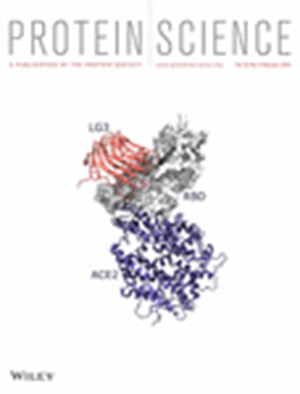MTR3D-AF2:使用 AlphaFold2 在人类蛋白质组中扩大空间推导的错义容忍度分数的覆盖范围。
IF 4.5
3区 生物学
Q1 BIOCHEMISTRY & MOLECULAR BIOLOGY
引用次数: 0
摘要
错义容忍度比(MTR)是作为一种评估变异的缺失性的新方法而开发的。其三维后继者 MTR3D 被证明在区分致病变异和良性变异方面功能强大。然而,它对实验结构和同源物的依赖限制了其对蛋白质组的覆盖。现在,我们利用 AlphaFold2 模型开发了 MTR3D-AF2,它覆盖了人类蛋白质组中 89.31% 的蛋白质和 85.39% 的残基。这项工作提高了 MTR3D 区分临床确定的致病变体和良性变体的能力。MTR3D-AF2 可在 https://biosig.lab.uq.edu.au/mtr3daf2/ 上以交互式网络服务器的形式免费获取。本文章由计算机程序翻译,如有差异,请以英文原文为准。
MTR3D-AF2: Expanding the coverage of spatially derived missense tolerance scores across the human proteome using AlphaFold2.
The missense tolerance ratio (MTR) was developed as a novel approach to assess the deleteriousness of variants. Its three-dimensional successor, MTR3D, was demonstrated powerful at discriminating pathogenic from benign variants. However, its reliance on experimental structures and homologs limited its coverage of the proteome. We have now utilized AlphaFold2 models to develop MTR3D-AF2, which covers 89.31% of proteins and 85.39% of residues across the human proteome. This work has improved MTR3D's ability to distinguish clinically established pathogenic from benign variants. MTR3D-AF2 is freely available as an interactive web server at https://biosig.lab.uq.edu.au/mtr3daf2/.
求助全文
通过发布文献求助,成功后即可免费获取论文全文。
去求助
来源期刊

Protein Science
生物-生化与分子生物学
CiteScore
12.40
自引率
1.20%
发文量
246
审稿时长
1 months
期刊介绍:
Protein Science, the flagship journal of The Protein Society, is a publication that focuses on advancing fundamental knowledge in the field of protein molecules. The journal welcomes original reports and review articles that contribute to our understanding of protein function, structure, folding, design, and evolution.
Additionally, Protein Science encourages papers that explore the applications of protein science in various areas such as therapeutics, protein-based biomaterials, bionanotechnology, synthetic biology, and bioelectronics.
The journal accepts manuscript submissions in any suitable format for review, with the requirement of converting the manuscript to journal-style format only upon acceptance for publication.
Protein Science is indexed and abstracted in numerous databases, including the Agricultural & Environmental Science Database (ProQuest), Biological Science Database (ProQuest), CAS: Chemical Abstracts Service (ACS), Embase (Elsevier), Health & Medical Collection (ProQuest), Health Research Premium Collection (ProQuest), Materials Science & Engineering Database (ProQuest), MEDLINE/PubMed (NLM), Natural Science Collection (ProQuest), and SciTech Premium Collection (ProQuest).
 求助内容:
求助内容: 应助结果提醒方式:
应助结果提醒方式:


